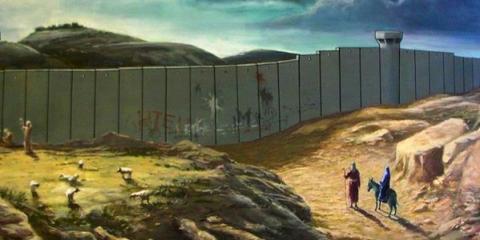
The following is a reprint of a news release by the U.S. Conference of Catholic Bishops on January 30, 2018. The following article was published in the March-April 2018 issue of NewsNotes.
Ten [U.S. Catholic] bishops made a pilgrimage to the Holy Land on January 18 – 27, 2018. In reflections issued at the conclusion of the Pilgrimage, they noted the "many walls and some bridges" they encountered as they "sought out those on the peripheries." The visit had as its theme, "Bridges, Not Walls," to help connect the bishops' domestic experiences of walls on the U.S. southern border to the reality of walls in the Holy Land.
They offer a number of reflections regarding their visit, including:
In Sderot, the city that has suffered the most from rocket attacks by Hamas, the bishops noted "they encountered the real fears of Israelis who grieve for the loss of lives," and also expressed great concern for their children who are "regularly required to practice air raid drills."
In addition to visiting Jerusalem, Nazareth, and many holy sites, where they celebrated daily Eucharist, the bishops traveled to Gaza and Jiffna in the Palestinian Territories to celebrate the Sunday Eucharist with "small, vibrant Christian communities."
They traveled extensively in the West Bank, including to Hebron, Susya and Bethlehem, witnessing firsthand the "stark reminders of the Israeli occupation—check-points that inhibit movement, confiscations of Palestinian lands, expansion of Israeli settlements, and a security barrier whose route cuts deep into the West Bank, which together with Israeli-only bypass roads, strangles natural urban growth and divides the Palestinian Territories into non-contiguous cantons."
The bishops also urge the U.S. government not to cut badly needed humanitarian and development assistance. They had met with families in Gaza and the West Bank who depend on aid for basic necessities, health care and education.
The bishops also express a particular concern for the dramatic decline of the Christian presence throughout the Holy Land, but also noted there are reasons for hope. In particular, they pointed to schools sponsored by the Church where persons of different religions study together, health ministries that serve the most vulnerable, and relief and development agencies doing heroic work.
The Pilgrimage for Peace was originally proposed by Bishop Oscar Cantú of Las Cruces, when he was Chairman of the USCCB Committee on International Justice and Peace, with the support of Bishop Nelson Jesus Perez of Cleveland, Chairman of the Sub-committee on Hispanic Affairs. Catholic Relief Services and the Holy Land Incoming Tour Operators Association partnered with the USCCB Office of International Justice and Peace in planning the Pilgrimage.
Calling for an end to violence and the occupation, the bishops are asking "Catholics to pray for the peoples of the Holy Land, to come on Pilgrimage to both the Holy Sites and the local Christian community, and to urge our nation's leaders to support policies that promote justice and peace."
The other bishops who participated were Bishop José Arturo Cepeda of Detroit, Bishop Octavio Cisneros of Brooklyn, Bishop Eusebio Elizondo, MSpS, of Seattle, Bishop Felipe de Jesús Estévez of St. Augustine, Bishop Armando Xavier Ochoa of Fresno, Bishop Rutilio del Riego of San Bernardino, Bishop Alberto Rojas of Chicago, and Bishop Plácido Rodriguez of Lubbock.
The full text of the statement can be found at http://bit.ly/2HLzZ2q
Photo: Nativity Wall believed to painted by British graffiti artist Banksy.
